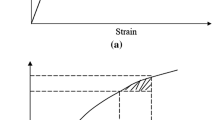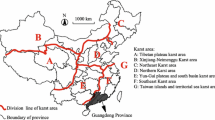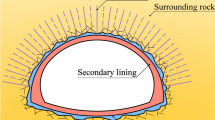Abstract
When shield tunnel passes through karst strata, the existence and development of karst caves will inevitably affect the safety of tunnel construction. Therefore, the karst caves in the construction area must be filled, and the backfill strength of karst caves will also affect the stability of surrounding rock. In this paper, the discrete element model of karst stratum is constructed by calibrating the discrete element EDEM mesoscopic parameters. The simulation of shield tunneling process under different karst cave filling intensities is realized. The influence of the ratio of cave filling strength to surrounding rock strength on the stability of surrounding rock is studied. The results show that: (1) Critical normal stress and normal contact stiffness only affect the peak stress, while critical tangential stress and tangential contact stiffness both affect elastic modulus and peak stress. (2) When the ratio of the filling strength of the cave in front of the shield to the strength of the surrounding rock is controlled between 0.8 and 1.2, the stability of the surrounding rock is less affected by the cave. (3) By comparing with the test results, when the ratio of the strength of cave filling material to the strength of surrounding rock is 0.8, the shield machine can safely pass through the front cave without excessive formation deformation. This study provides a basis for the treatment of karst caves when shield tunneling through karst areas.

















Similar content being viewed by others
Data Availability
Enquiries about data availability should be directed to the authors.
References
Cardu M, Oreste P (2013) Tunnelling in urban areas by EPB machines: technical evaluation of the system. Earth Res J 15(1):5–11. https://doi.org/10.1029/2011GL047134
Chakeri H, Ozcelik Y, Unver B (2013) Effects of important factors on surface settlement prediction for metro tunnel excavated by EPB. Tunnel Undergr Space Technol 36:14–23. https://doi.org/10.1016/j.tust.2013.02.002
Ercelebi SG, Copur H, Ocak I (2011) Surface settlement predictions for Istanbul metro tunnels excavated by EPB-TBM. Environ Earth Sci 62(2):357–365. https://doi.org/10.1007/s12665-010-0530-6
Eskandari F, Goharrizi KG, Hooti A (2018) The impact of EPB pressure on surface settlement and face displacement in intersection of triple tunnels at Mashhad metro. Geomech Eng 15(2):769–774. https://doi.org/10.12989/gae.2018.15.2.769
Fang Y, He C, Nazem A, Yao Z, Grasmick J (2017) Surface settlement prediction for EPB shield tunneling in sandy ground. KSCE J Civ Eng 21:2908–2918. https://doi.org/10.1007/s12205-017-0989-8
Feo A, Zanini A, Petrella E, Hernàndez-Diaz R, Celico F (2019) Analysis of the saltwater wedge in a coastal karst aquifer with a double conduit network, numerical simulations and sensitivity analysis. Water 11(11):2311. https://doi.org/10.3390/w11112311
Hui H, Bowen Z, Yanyan Z, Chunmei Z, Yize W, Zeng G (2017) The mechanism and numerical simulation analysis of water bursting in filling karst tunnel. Geotech Geol Eng 36:1197–1205. https://doi.org/10.1007/s10706-017-0386-6
Jiang C, Shi H, Li Y, Yu H (2016) Numerical simulation of groundwater under complex karst conditions and the prediction of roadway gushing in a coal mine: a case study in the Guang’an longtan reservoir in Sichuan province, China. Acta Geochimica 35(001):72–84. https://doi.org/10.1007/s11631-015-0077-z
Lai YB, Wang MS, You XH (2014) Study of safe distance criterion between concealed karst cave and tunnel. Appl Mech Mater 556–562:849–852. https://doi.org/10.4028/www.scientific.net/AMM.556-562.849
Li JP, Nie QK, Liu QS, Yu JC (2018) Risk assessment method of karst ground collapse based on weight back analysis. Yantu Lixue/rock Soil Mech 39(4):1395–1400. https://doi.org/10.16285/j.rsm.2016.1048
Li SC, Wang K, Li LP, Zhou ZQ, Shi SS, Liu S (2017) Mechanical mechanism and development trend of water-inrush disasters in karst tunnels. Chin J Theor Appl Mech 49(1):22–30. https://doi.org/10.6052/0459-1879-16-345 (in Chinese)
Li L, Sun S, Wang J, Yang W, Fang Z (2020) Experimental study of the precursor information of the water inrush in shield tunnels due to the proximity of a water-filled cave. Int J Rock Mech Min Sci 130:104320. https://doi.org/10.1016/j.ijrmms.2020.104320
Lv J, Li X, Fu H, Tang Y, Li Z, Zhao H (2020) Influence of shield tunnel construction on ground surface settlement under the condition of upper-soft and lower-hard composite strata. J Vibroeng 22(5):1126–1144. https://doi.org/10.21595/JVE.2020.20967
Meguid MA, Dang HK (2009) The effect of erosion voids on existing tunnel linings. Tunn Undergr Space Technol Incorp Trench Technol Res 24(3):278–286. https://doi.org/10.1016/j.tust.2008.09.002
Mu W, Wu Q, Xing Y, Qian C, Wang Y, Du Y (2018) Using numerical simulation for the prediction of mine dewatering from a karst water system underlying the coal seam in the Yuxian Basin, Northern China. Environ Earth Sci 77(5):215. https://doi.org/10.1007/s12665-018-7389-3
Wang W, Gao S, Liu L, Wen W, Li P, Chen J (2019b) Analysis on the safe distance between shield tunnel through sand stratum and underlying karst cave. Geosyst Eng 22(2):81–90. https://doi.org/10.1080/12269328.2018.1475265
Wang W, Gao SM, Min YW et al (2019a) Three-dimensional fluid-solid coupling numerical simulation of effects of underlying karst cave on shield tunnel through sand stratum. Geotech Geol Eng 37:4825–4836. https://doi.org/10.1007/s10706-019-00941-x
Xu ZH, Wu J, Li SC, Zhang B, Huang X (2018) Semianalytical solution to determine minimum safety thickness of rock resisting water inrush from filling-type karst caves. Int J Geomech 18(2):04017152. https://doi.org/10.1061/(ASCE)GM.1943-5622.0001071
Funding
This work was supported by the National Natural Science Foundation of China (No. 51879148, 51809158), Shandong Provincial Key Research and Development Program (Major Scientific and Technological Innovation Project) (No. 2019JZZY010428), Transportation Science and technology plan of Shandong Province in 2019 (No. 2019B47_1).
Author information
Authors and Affiliations
Contributions
Conceptualization, ZF and JW; methodology, ND; software, RD; validation, XB, JH and ZZ; formal analysis, ZF; resources, WY and ND; writing—original draft preparation, ZF; writing—review and editing, ZF and WY; supervision, ZD. All authors have read and agreed to the published version of the manuscript.
Corresponding authors
Ethics declarations
Conflicts of Interests
On behalf of all authors, the corresponding author states that there is no conflict of interest.
Additional information
Publisher's Note
Springer Nature remains neutral with regard to jurisdictional claims in published maps and institutional affiliations.
Rights and permissions
Springer Nature or its licensor (e.g. a society or other partner) holds exclusive rights to this article under a publishing agreement with the author(s) or other rightsholder(s); author self-archiving of the accepted manuscript version of this article is solely governed by the terms of such publishing agreement and applicable law.
About this article
Cite this article
Fang, Z., Ding, N., Yang, W. et al. The Influence of Different Karst Cave Filling Material Strengths on Stratum Stability During Shield Tunneling. Geotech Geol Eng 41, 1309–1323 (2023). https://doi.org/10.1007/s10706-022-02337-w
Received:
Accepted:
Published:
Issue Date:
DOI: https://doi.org/10.1007/s10706-022-02337-w




